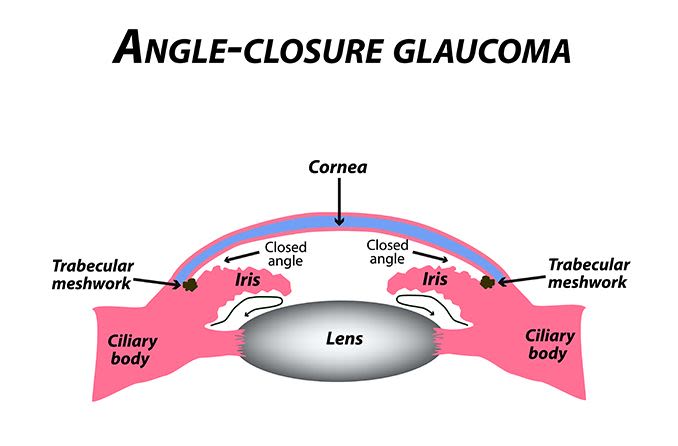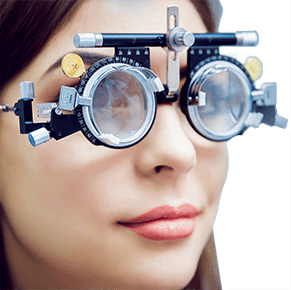Narrow-Angle Glaucoma

Acute narrow-angle glaucoma occurs suddenly, when the colored portion of your eye (iris) is pushed or pulled forward. This causes blockage of the drainage angle of the eye, where the trabecular meshwork allows outflow of fluids.
When internal eye structures are blocked in this way, your eye's internal pressure (intraocular pressure or IOP) may spike and possibly damage the optic nerve that transmits images from the eye to the brain.
Acute angle-closure (closed-angle or narrow-angle) glaucoma produces symptoms such as eye pain, headaches, halos around lights, dilated pupils, vision loss, red eyes, nausea and vomiting.
These signs may last for hours or until the IOP is reduced. With each narrow-angle glaucoma attack, part of your peripheral vision may be lost.
Acute angle-closure glaucoma is a medical emergency. If the high eye pressure is not reduced within hours, it can cause permanent vision loss. Anyone who experiences these symptoms should contact an ophthalmologist immediately or go to a hospital emergency room.
Some chronic forms of narrow-angle glaucoma, however, can progress very slowly and cause eye damage without any obvious symptoms or pain in early stages.
Causes of Narrow-Angle Glaucoma
Causes of the abnormal positioning of the iris in narrow-angle glaucoma include:
Pupillary block.
Eye fluid known as the aqueous humor is produced in the ciliary body, which is located behind the iris. Normally, the aqueous flows easily through the pupil into the front or anterior chamber of the eye.
But if the back of the iris adheres to the lens inside the eye, this pupillary channel becomes blocked. Then fluid backs up behind the iris, pushing the iris forward until it closes the drainage angle in the anterior chamber.
Iris plateau.
In this condition, the iris is attached to the ciliary body too close to the trabecular meshwork, where drainage occurs. When the pupil dilates, the peripheral iris tissue bunches up in the drainage angle and can cover up the trabecular meshwork, causing IOP to rise quickly.
This type of narrow-angle glaucoma attack can occur in conditions when the pupil dilates in dim lighting or when eye drops are used to intentionally enlarge the pupil during an eye exam.
Hyperopia.
People who are farsighted are more likely to have eyes with shallow anterior chambers and narrow angles, increasing their risk for angle-closure glaucoma from pupil dilation or aging changes in the eye.
Tumors and other causes.
A tumor behind the iris, swelling associated with inflammation of the ciliary body (intermediate uveitis) and alteration of the shape of the eye after surgery for a detached retina also can cause angle-closure glaucoma.
Risk Factors for Narrow-Angle Glaucoma
In addition to hyperopia, risk factors for acute angle-closure glaucoma include:
Sudden eye pain, headaches and red eyes can be symptoms of narrow-angle glaucoma.
Age.
As we grow older, the lens inside our eyes gets larger, increasing the risk for pupil block. Also, the anterior chamber tends to become increasingly shallow, and the drainage angle may narrow as we age.
Race.
Asians, as well as Inuits and other northern indigenous people, who have anatomically narrower anterior chamber angles than whites, have a higher incidence of angle-closure glaucoma.
Sex.
Among Caucasians, angle-closure glaucoma occurs three times more frequently in women than in men. Among African-Americans, men and women appear to be affected equally.
Treatment of Narrow-Angle Glaucoma
The goal of treatment is to reduce intraocular pressure as soon as possible.
This can be done with systemic medications taken orally or sometimes given intravenously. Topical eye drops for glaucoma also are often used to treat narrow-angle glaucoma. Frequently, laser and/or nonlaser glaucoma surgery may be required to reduce the IOP.
Remember that acute angle-closure glaucoma may be triggered by anything dilating the pupil, resulting in the iris blocking the drainage angle in the eye's anterior chamber.
Dim lighting, eye drops administered by your eye care practitioner during an eye examination or certain medications such as antihistamine/decongestant drops or cold medications may cause an acute angle-closure glaucoma attack.
In acute forms of glaucoma, optic nerve damage and permanent vision loss can occur within hours if the eye's drainage angle is not opened to allow the excess aqueous to exit the eye, thereby reducing the intraocular pressure.
With contributions and review by Charles Slonim, MD and Marilyn Haddrill.
Page published on Monday, March 4, 2019






